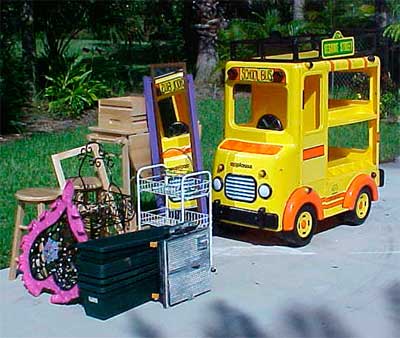 If you've been paying attention to the food circulars lately you already know that grocers are jumping on the band wagon these days in a concerted effort to get your attention fixed on organic products. Retailers like Giant Food, Kash n' Karry, Publix, Albertsons even embattled Winn Dixie have recently began touting 'organic' and putting in place special selections of organic produce, canned goods, pantry, dairy and meat items all proclaimed USDA Organic Certified. But at what cost and how can you, the consumer, be certain that the benefits justify the increased cost for you and your family.
If you've been paying attention to the food circulars lately you already know that grocers are jumping on the band wagon these days in a concerted effort to get your attention fixed on organic products. Retailers like Giant Food, Kash n' Karry, Publix, Albertsons even embattled Winn Dixie have recently began touting 'organic' and putting in place special selections of organic produce, canned goods, pantry, dairy and meat items all proclaimed USDA Organic Certified. But at what cost and how can you, the consumer, be certain that the benefits justify the increased cost for you and your family.Organic labeling guarantees that certain conventions are maintained in the production and processing of consumable agricultural goods, conventions that specify: restrictions for beef, pork and poultry producers that prohibit the use of antibiotics and allow only organically grown feed, composting, and organic fertilizers. Crop rotation methods that enhance the soil but reduce in the short term a farmer's cash crop production are also mandated by the seal. These restrictions add to the cost up the chain beginning with the producer - the farm - and continue on to the wholesale and ultimately the retail level where they are passed directly to the consumer.
We checked 3 national chain grocers this week and found these relative* costs for 12 items labeled organic versus non organic. The value averaged totals are as follows.
| organic | non organic | |
| 1 pound fresh shrimp** | 8.99 | 9.99 |
| 1 pound vine ripe tomatos | 2.32 | 2.19 |
| 1 dozen eggs | 2.99 | 1.79 |
| 1 24 ounce loaf whole wheat bread | 2.99 | 2.09 |
| 1 27 ounce multigrain cereal | 3.29 | 2.79 |
| 1 64 ounce apple juice | 2.29 | 1.79 |
| 1 5 ounce bag salad mixed greens | 2.99 | 2.39 |
| 14.5 ounce can soup various varieties | 2.19 | 1.89 |
| 16.3 ounce bottle pasta sauce | 2.39 | 2.69 |
| 1 14 ounce long grain brown rice | 1.19 | 1.59 |
| 1 15.25 ounce can corn | .99 | .78 |
| 1 5 pound bag bread flour | 2.39 | 2.89 |
| total | 35.01 | 32.88 |
The difference amounts to roughly a 6% increase to the cost of organic foods over non-organic.
*note - we disregarded sale pricing in both categories at all 3 chains
**note - organic sea food, meat, fowl and dairy products cannot be verified nor compared to soy substitute products in the same category because the source of protein in each, although of similar quality, is based on entirely different organic standards.
 Anytime the car won't fit in the garage is a good time to consider recycling. But, as often happens, this becomes a real chore; finding a recycling station or paying extra fees to have the items picked up and taken to a landfill and then sorting it beforehand, better to just leave the family car out in the elements another week. Or, why not consider donate and recycle, the green solution to freeing up garage space, making your life easier and going easy on the environment all at the same time.
Anytime the car won't fit in the garage is a good time to consider recycling. But, as often happens, this becomes a real chore; finding a recycling station or paying extra fees to have the items picked up and taken to a landfill and then sorting it beforehand, better to just leave the family car out in the elements another week. Or, why not consider donate and recycle, the green solution to freeing up garage space, making your life easier and going easy on the environment all at the same time.We've compiled a list of alternatives to a trip to the dump for nearly everything you want to get rid of - make that recycle. From electronics to toys, unwanted clothing , furniture, even spent batteries, half used cleaning products and paint that may no longer be safe around your home, we'll show you ways to recycle it all.
Some of these resources are community run such as local recyling days or regular pick ups by a recycle center. Others are privately operated and will gladly pick up items which are no longer wanted by the homeowner, sometimes for a fee and sometimes free of charge depending on the type of items you have. Still others are operated by charitable organizations and benefit a particular charity, cause or association.
Any of these options can benefit your community in many ways. By recycling some still useful item you have made an economic contribution to the community, preserved valuable space in local landfill and provided incentives for industry and jobs in your area.
So the next time you want to lighten the load around your home think of recycling first, its the Greener thing to do.
Check our resources page Green Market for recycling information in your community. We'll maintain this page and update it as new resources becomes available. If you know of a recycle resource in your community send it to us. We'll tell everybody and give you the "Greener" credit.

 Please recycle this Newsletter to a friend
Please recycle this Newsletter to a friend

